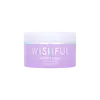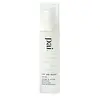What's inside
What's inside
 Key Ingredients
Key Ingredients

 Benefits
Benefits

 Concerns
Concerns

 Ingredients Side-by-side
Ingredients Side-by-side

Water
Skin ConditioningDimethicone
EmollientDipropylene Glycol
HumectantGlycerin
HumectantGlycereth-26
HumectantPCA Dimethicone
Skin ConditioningCetearyl Alcohol
EmollientBis-Diglyceryl Polyacyladipate-2
EmollientNiacinamide
SmoothingGlyceryl Stearate
EmollientPEG-100 Stearate
Biosaccharide Gum-4
Skin ConditioningHoney Extract
HumectantLavandula Angustifolia Oil
MaskingCurcuma Longa Root Extract
MaskingAdenosine
Skin ConditioningCarthamus Tinctorius Seed Oil
MaskingCitrullus Lanatus Fruit Extract
Skin ConditioningLeuconostoc/Radish Root Ferment Filtrate
AntimicrobialCeramide NP
Skin ConditioningCaprylic/Capric Triglyceride
MaskingDipotassium Glycyrrhizate
HumectantCaprylyl Glycol
EmollientHydrogenated Lecithin
EmulsifyingXanthan Gum
EmulsifyingPolysorbate 60
EmulsifyingTocopheryl Acetate
AntioxidantAmmonium Acryloyldimethyltaurate/Vp Copolymer
Disodium EDTA
Phenoxyethanol
PreservativeLinalool
PerfumingGeraniol
PerfumingLimonene
PerfumingMica
Cosmetic ColorantTin Oxide
AbrasiveCI 77891
Cosmetic ColorantWater, Dimethicone, Dipropylene Glycol, Glycerin, Glycereth-26, PCA Dimethicone, Cetearyl Alcohol, Bis-Diglyceryl Polyacyladipate-2, Niacinamide, Glyceryl Stearate, PEG-100 Stearate, Biosaccharide Gum-4, Honey Extract, Lavandula Angustifolia Oil, Curcuma Longa Root Extract, Adenosine, Carthamus Tinctorius Seed Oil, Citrullus Lanatus Fruit Extract, Leuconostoc/Radish Root Ferment Filtrate, Ceramide NP, Caprylic/Capric Triglyceride, Dipotassium Glycyrrhizate, Caprylyl Glycol, Hydrogenated Lecithin, Xanthan Gum, Polysorbate 60, Tocopheryl Acetate, Ammonium Acryloyldimethyltaurate/Vp Copolymer, Disodium EDTA, Phenoxyethanol, Linalool, Geraniol, Limonene, Mica, Tin Oxide, CI 77891
Water
Skin ConditioningSimmondsia Chinensis Seed Oil
EmollientPersea Gratissima Oil
Skin ConditioningCarthamus Tinctorius Seed Oil
MaskingCetearyl Alcohol
EmollientGlycerin
HumectantBorago Officinalis Seed Oil
EmollientButyrospermum Parkii Butter
Skin ConditioningCetearyl Glucoside
EmulsifyingPelargonium Graveolens Oil
MaskingLitsea Cubeba Fruit Oil
MaskingJasminum Grandiflorum Flower Extract
MaskingTocopherol
AntioxidantHelianthus Annuus Seed Oil
EmollientSodium Levulinate
Skin ConditioningSodium Anisate
AntimicrobialSodium Stearoyl Glutamate
CleansingSodium Caproyl/Lauroyl Lactylate
AntimicrobialLactic Acid
BufferingBeta-Sitosterol
Emulsion StabilisingSqualene
EmollientWater, Simmondsia Chinensis Seed Oil, Persea Gratissima Oil, Carthamus Tinctorius Seed Oil, Cetearyl Alcohol, Glycerin, Borago Officinalis Seed Oil, Butyrospermum Parkii Butter, Cetearyl Glucoside, Pelargonium Graveolens Oil, Litsea Cubeba Fruit Oil, Jasminum Grandiflorum Flower Extract, Tocopherol, Helianthus Annuus Seed Oil, Sodium Levulinate, Sodium Anisate, Sodium Stearoyl Glutamate, Sodium Caproyl/Lauroyl Lactylate, Lactic Acid, Beta-Sitosterol, Squalene
 Reviews
Reviews

Ingredients Explained
These ingredients are found in both products.
Ingredients higher up in an ingredient list are typically present in a larger amount.
Carthamus tinctorius seed oil comes from safflower, one of humanity's oldest crops.
Safflower seed oil contains a high percentage of linoleic acid and oleic acid. It also contains Vitamin E. These three components are effective moisturizers.
Vitamin E helps nourish your skin's lipid barrier. It is also a potent antioxidant. Antioxidants help fight free-radical molecules, or unstable molecules that may damage your skin cells.
Due to its high fatty acid content, this ingredient may not be malassezia folliculitis safe.
Thoughout history, safflower has been used for dying fabrics and in food as a saffron substitute.
Learn more about Carthamus Tinctorius Seed OilCetearyl alcohol is a mixture of two fatty alcohols: cetyl alcohol and stearyl alcohol. It is mainly used as an emulsifier. Emulsifiers help prevent the separation of oils and products. Due to its composition, it can also be used to thicken a product or help create foam.
Cetearyl alcohol is an emollient. Emollients help soothe and hydrate the skin by trapping moisture.
Studies show Cetearyl alcohol is non-toxic and non-irritating. The FDA allows products labeled "alcohol-free" to have fatty alcohols.
This ingredient is usually derived from plant oils such as palm, vegetable, or coconut oils. There is debate on whether this ingredient will cause acne.
Due to the fatty acid base, this ingredient may not be Malassezia folliculitis safe.
Learn more about Cetearyl AlcoholGlycerin is already naturally found in your skin. It helps moisturize and protect your skin.
A study from 2016 found glycerin to be more effective as a humectant than AHAs and hyaluronic acid.
As a humectant, it helps the skin stay hydrated by pulling moisture to your skin. The low molecular weight of glycerin allows it to pull moisture into the deeper layers of your skin.
Hydrated skin improves your skin barrier; Your skin barrier helps protect against irritants and bacteria.
Glycerin has also been found to have antimicrobial and antiviral properties. Due to these properties, glycerin is often used in wound and burn treatments.
In cosmetics, glycerin is usually derived from plants such as soybean or palm. However, it can also be sourced from animals, such as tallow or animal fat.
This ingredient is organic, colorless, odorless, and non-toxic.
Glycerin is the name for this ingredient in American English. British English uses Glycerol/Glycerine.
Learn more about GlycerinWater. It's the most common cosmetic ingredient of all. You'll usually see it at the top of ingredient lists, meaning that it makes up the largest part of the product.
So why is it so popular? Water most often acts as a solvent - this means that it helps dissolve other ingredients into the formulation.
You'll also recognize water as that liquid we all need to stay alive. If you see this, drink a glass of water. Stay hydrated!
Learn more about Water